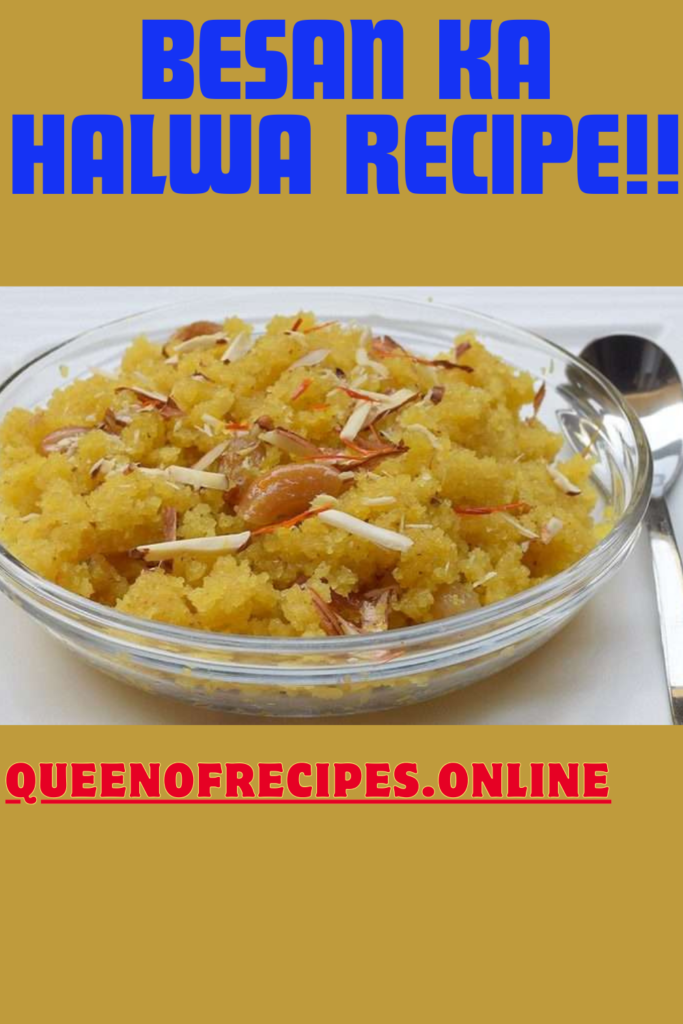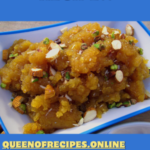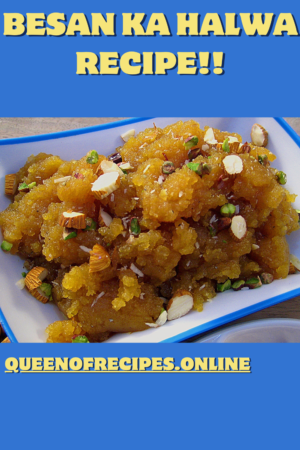Table of Contents
About Besan Ka Halwa.
Besan Ka Halwa, a cherished Indian dessert, is a delectable, sweet treat made from roasted gram flour (besan), ghee (clarified butter), sugar, and flavored with aromatic spices. It’s known for its rich, nutty flavor and the irresistible fragrance that fills the kitchen during its preparation. It is a popular dish during festivals and special occasions, loved for its warm and comforting taste, making it a quintessential part of Indian culinary traditions.
Making Besan Ka Halwa at home is a delightful process, and here’s a simple recipe to guide you:
Ingredients for making Besan Ka Halwa:
- 1 cup besan (gram flour)
- 1/2 cup ghee (clarified butter)
- 1/2 cup sugar
- 1 1/2 cups warm milk
- 1/2 teaspoon cardamom powder
- A handful of chopped nuts (almonds, cashews)
- A pinch of saffron strands (optional)
- Raisins for garnish
Instructions for making Besan Ka Halwa:
- Roast the Besan:
- Heat ghee in a heavy-bottomed pan on low to medium heat. Add besan and roast it, stirring continuously. Keep roasting until the besan turns golden brown and releases a nutty aroma. This can take about 10-15 minutes.
- Add Warm Milk:
- Slowly add warm milk to the roasted besan while stirring to avoid lumps. Continue to cook, stirring to ensure the mixture blends smoothly.
- Add Sugar:
- Once the mixture thickens and starts to leave the sides of the pan, add sugar. Stir well to combine, and the mixture will become slightly liquidy again.
- Flavor with Cardamom:
- Add cardamom powder and continue to cook. The halwa will thicken and start to come together.
- Garnish and Saffron (Optional):
- Add chopped nuts and saffron strands if using. Stir them into the halwa.
- Cook Until Ghee Separates:
- Keep cooking the halwa until it thickens further, and you see ghee separating from the mixture. It should have a glossy appearance.
- Garnish with Raisins:
- Remove from heat and garnish it with raisins.
- Serve Warm:
- Serve the halwa warm. It can be enjoyed on its own or with a dollop of ghee.
Besan Ka Halwa is a warm and comforting dessert, perfect for celebrations and special occasions. Enjoy its rich, nutty flavor and aromatic spices.
How can we enhance the flavor of Besan ka Halwa?
Enhancing the flavor of Besan Ka Halwa can make it even more delightful. Here are some tips to elevate its taste:
- High-Quality Ghee: Start with premium-quality ghee. Pure desi ghee adds a rich, nutty flavor and aroma that significantly enhances the halwa.
- Roasting Gram Flour: Roast the gram flour (besan) carefully until it turns a deep golden brown. This process intensifies its nutty flavor and eliminates any raw taste.
- Balanced Sugar: Adjust the quantity of sugar to your preference, but avoid making the halwa overly sweet. The sweetness should complement the nutty richness.
- Cardamom: Adding cardamom powder imparts a delightful fragrance and flavor. You can crush the seeds of green cardamom pods for a fresh aroma.
- Nuts and Dry Fruits: Roast nuts like almonds and cashews in ghee before adding them to the halwa. This step intensifies their flavor and provides a delightful crunch.
- Saffron: Infuse saffron strands in a little warm milk and add this to the halwa for a subtle, exotic touch and a hint of color.
- Nutmeg: A pinch of grated nutmeg can add depth to the flavor profile, enhancing the overall taste.
- Additional Flavorings: Experiment with other flavorings like rose water, kewra water, or a few drops of almond essence for a unique and aromatic twist.
- Garnishes: Top the halwa with raisins, chopped nuts, or even edible silver foil (varak) for an elegant presentation and added texture.
- Time and Patience: Allow the halwa to cook thoroughly on a low flame. Longer cooking times can help meld the flavors and create a richer taste.
By following these tips and personalizing the flavor elements to your liking, you can create a Besan Ka Halwa that’s exceptionally flavorful and memorable.


Nutritional Value for Besan Ka Halwa.
The nutritional value of it can vary based on the specific recipe and portion size. Here’s an approximate breakdown of the nutritional content in a standard serving size, which is approximately one small bowl (about 100 grams) of Besan Ka Halwa:
- Calories: One serving of Besan Ka Halwa contains around 350-400 calories. The calorie content may vary based on the quantity of ghee and sugar used.
- Carbohydrates: A standard serving typically provides about 40-45 grams of carbohydrates, primarily from the besan (gram flour) and sugar.
- Protein: It contains approximately 5-7 grams of protein per serving, mainly from the gram flour.
- Fat: One serving can have 15-20 grams of fat, with ghee being the primary source.
- Saturated Fat: Saturated fat content varies but is typically around 7-10 grams in one serving.
- Sugar: A serving of Besan Ka Halwa contains about 20-25 grams of sugar, which includes both natural sugars and added sugar.
- Fiber: There’s minimal dietary fiber in Besan Ka Halwa Ovides some essential nutrients such as iron, calcium, and small amounts of vitamins from the gram flour and milk used.
It’s important to note that these values are approximate and can vary depending on the specific ingredients and proportions used in the recipe. It is a sweet indulgence and should be enjoyed in moderation due to its calorie, sugar, and fat content.
Health Benefits of Besan Ka Halwa.
Besan Ka Halwa, a traditional Indian dessert, offers a few potential health benefits:
- Protein Source: Gram flour (besan), a primary ingredient in Besan Ka Halwa, is a good source of plant-based protein. Protein is essential for various bodily functions, including muscle repair and growth.
- Energy Boost: The combination of ghee and sugar in the halwa provides a quick source of energy. It’s often consumed during festivals and special occasions to provide an energy boost.
- Rich in Healthy Fats: Ghee, used in the preparation, contains healthy fats, including monounsaturated fats. These fats can support the absorption of fat-soluble vitamins and contribute to overall health.
- Iron Content: Gram flour contains iron, which is vital for maintaining healthy blood and preventing iron-deficiency anemia.
- Flavor and Comfort: It’s warm and comforting taste can provide a sense of satisfaction and happiness, making it a mood-enhancing dessert.
However, it’s important to consume Besan Ka Halwa in moderation due to its calorie and sugar content. Excessive consumption can lead to weight gain and other health issues. Additionally, portion size and ingredients used can significantly affect its nutritional profile, so it’s advisable to be mindful of your intake.
Tips and Tricks for making Besan ka Halwa.
Creating a perfect Besan Ka Halwa is an art that requires careful attention and technique. Here are some tips and tricks to help you make this delightful dessert:
1. Roast the Besan Thoroughly: Roasting the gram flour (besan) in ghee until it turns golden brown is crucial. This step enhances the flavor of the halwa and eliminates any raw taste. Be patient during this process and stir continuously to prevent burning.
2. Use Quality Ghee: Choose high-quality ghee, as it significantly impacts the taste and aroma of the halwa. Pure desi ghee works exceptionally well.
3. Balanced Sugar: Adjust the amount of sugar to your preference, but don’t go overboard. Keep in mind that the halwa will naturally sweeten as it cooks and that you can add more sugar later if needed.
4. Consistent Stirring: Stir the halwa continuously while adding ingredients like milk and sugar. This prevents lumps from forming and ensures a smooth consistency.
5. Spices and Flavorings: Enhance the halwa’s flavor with cardamom powder, saffron strands, or a pinch of nutmeg. These aromatic additions can elevate the taste.
6. Use Warm Milk: When adding milk, ensure it’s warm, not cold. Cold milk can cause the halwa to seize or form lumps.
7. Nuts and Dry Fruits: Roast nuts like almonds and cashews in ghee before adding them to the halwa. This step intensifies their flavor and provides a delightful crunch.
8. Serve Hot: It is best enjoyed hot. It tends to thicken as it cools, so if it becomes too thick, you can add a little warm milk to adjust the consistency when reheating.
9. Experiment with Garnishes: Garnish the halwa with raisins, chopped nuts, or a few strands of saffron for an elegant presentation and added texture.
10. Practice Patience: Making it requires patience, especially while roasting the besan. Taking your time and paying attention to details will yield the best results.
With these tips and tricks, you can create a rich and flavorful Besan Ka Halwa that’s sure to be a hit during festivals and special occasions.


Serving Suggestions for Besan Ka Halwa.
Besan Ka Halwa is a warm and comforting Indian dessert that’s perfect for festive occasions and special gatherings. Here are some serving suggestions to enhance your enjoyment of this delightful sweet treat:
- Garnish with Nuts: Serve the Besan Ka Halwa in individual bowls, and garnish each portion with a generous sprinkling of finely chopped almonds, cashews, and pistachios. The nuts add a delightful crunch and visual appeal.
- A Dollop of Ghee: Add a small dollop of pure desi ghee (clarified butter) on top of each serving just before serving. It not only enhances the flavor but also adds an authentic touch to the halwa.
- Warm Presentation: It is best enjoyed warm, so make sure to serve it freshly prepared and hot. The comforting aroma and warmth of the halwa are part of the experience.
- Accompaniments: You can serve Besan Ka Halwa on its own or pair it with other Indian sweets like Gulab Jamun, Jalebi, or Rabri for a diverse dessert platter during festive occasions.
- Traditional Thali: To create an authentic Indian dining experience, serve Besan Ka Halwa on a traditional thali (metal plate) with a katori (small bowl) for a truly traditional presentation.
- Tea or Coffee: Besan Ka Halwa pairs beautifully with a cup of hot masala tea (chai) or aromatic coffee. The contrast between the sweet halwa and the slightly spiced beverages is delightful.
- Decorative Plating: For special occasions, you can serve the halwa on decorative plates or bowls with traditional Indian patterns for a visually appealing presentation.
- Festive Occasions: Besan Ka Halwa is a popular choice during celebrations like Diwali, weddings, and other festivals. Serving it in elegant bowls with a few rose petals as garnish adds a festive touch.
Remember to savor the rich and nutty flavors of Besan Ka Halwa while enjoying the warmth and hospitality it represents. Whether served during special occasions or as a sweet indulgence, this dessert is sure to leave a lasting impression.
FAQs for Besan Ka Halawa.
How is Besan Ka Halwa different from other Indian sweets?




Besan Ka Halwa stands out from other Indian sweets due to its unique characteristics:
Ingredients: It’s primarily made from roasted gram flour (besan), ghee (clarified butter), and sugar, resulting in a distinct nutty flavor and a rich, creamy texture.
Roasted Gram Flour: Unlike sweets such as Gulab Jamun or Jalebi, Besan Ka Halwa requires roasting the gram flour until it turns golden brown, which adds a deeper, earthy flavor.
Aromatic Spices: Besan Ka Halwa is often flavored with cardamom, enhancing its aroma and taste. This sets it apart from other sweets that might use different spices or none at all, contributing to its unique profile.
Can Besan Ka Halwa be served cold?



While Besan Ka Halwa is traditionally enjoyed warm, it can also be served at room temperature or slightly chilled if you prefer a different experience. Serving it cold alters the texture, making it a bit firmer compared to its warm, creamy consistency. The choice of serving temperature ultimately depends on personal preference, and both options have their own appeal.
How do I prevent lumps in Besan Ka Halwa?




Preventing lumps in Besan Ka Halwa requires careful cooking and constant stirring. Here’s how to do it:
Sift the Gram Flour: Before you begin, sift the gram flour to ensure it’s free of any lumps. This initial step can help prevent clumps in the halwa.
Low to Medium Heat: Use low to medium heat when roasting the gram flour in ghee. Cooking on high heat can lead to lumps forming quickly.
Constant Stirring: Stir the gram flour continuously as it roasts. Ensure there are no pockets of dry flour, and the mixture is uniform.
Gradual Milk Addition: When you add warm milk to the roasted gram flour, do it gradually and in a steady stream while stirring. This gradual addition helps to create a smoother consistency.
Break Lumps: If you notice any lumps forming, use a spatula or the back of a spoon to break them up as you stir. Continue stirring until the mixture becomes smooth.
Straining (Optional): If lumps persist, you can strain the mixture through a fine-mesh sieve to remove them before proceeding with the recipe.
With these steps, you can achieve a lump-free and silky-smooth Besan Ka Halwa. The key is patience and vigilance during the cooking process.
How long does Besan Ka Halwa stay fresh?



Besan Ka Halwa can be stored in the refrigerator for several days. When properly stored in an airtight container, it typically remains fresh for about 3 to 5 days. However, over time, it may thicken and lose some of its original texture. To enjoy it after refrigeration, you may need to reheat it and adjust the consistency with a little warm milk, if necessary. Always check for any signs of spoilage, such as changes in color or odor, before consuming stored Besan Ka Halwa.
Can I make a healthier version of Besan Ka Halwa?




Yes, it’s possible to make a healthier version of Besan Ka Halwa by making a few modifications:
Reduced Ghee: Use less ghee than traditional recipes call for. While ghee adds flavor, using it in moderation can reduce the overall fat content.
Alternative Sweeteners: Replace refined sugar with healthier sweeteners like jaggery or honey. These options add a unique taste and might be considered healthier alternatives.
Nutrient-Rich Flours: Combine gram flour (besan) with other flours like almond flour or whole wheat flour to increase the nutrient content and reduce the glycemic load.
Plant-Based Ingredients: Use plant-based ghee substitutes and non-dairy milk for a vegan version that’s lower in saturated fat.
Portion Control: Be mindful of portion sizes. Reducing the serving size can make a big difference in calorie and sugar intake.
While these modifications can make Besan Ka Halwa healthier, it’s important to remember that it may not have the same rich and indulgent flavor as the traditional version. Balancing health and taste is key, and the extent of these changes can vary based on individual dietary preferences and health goals.

